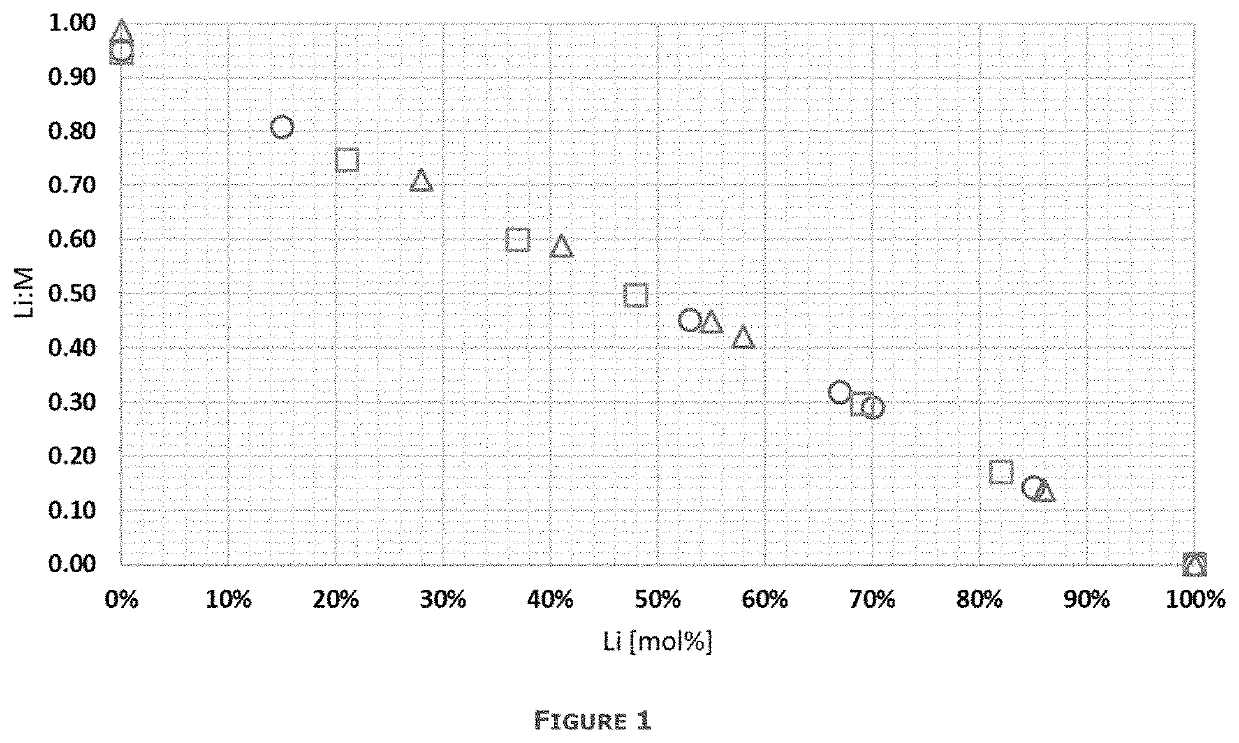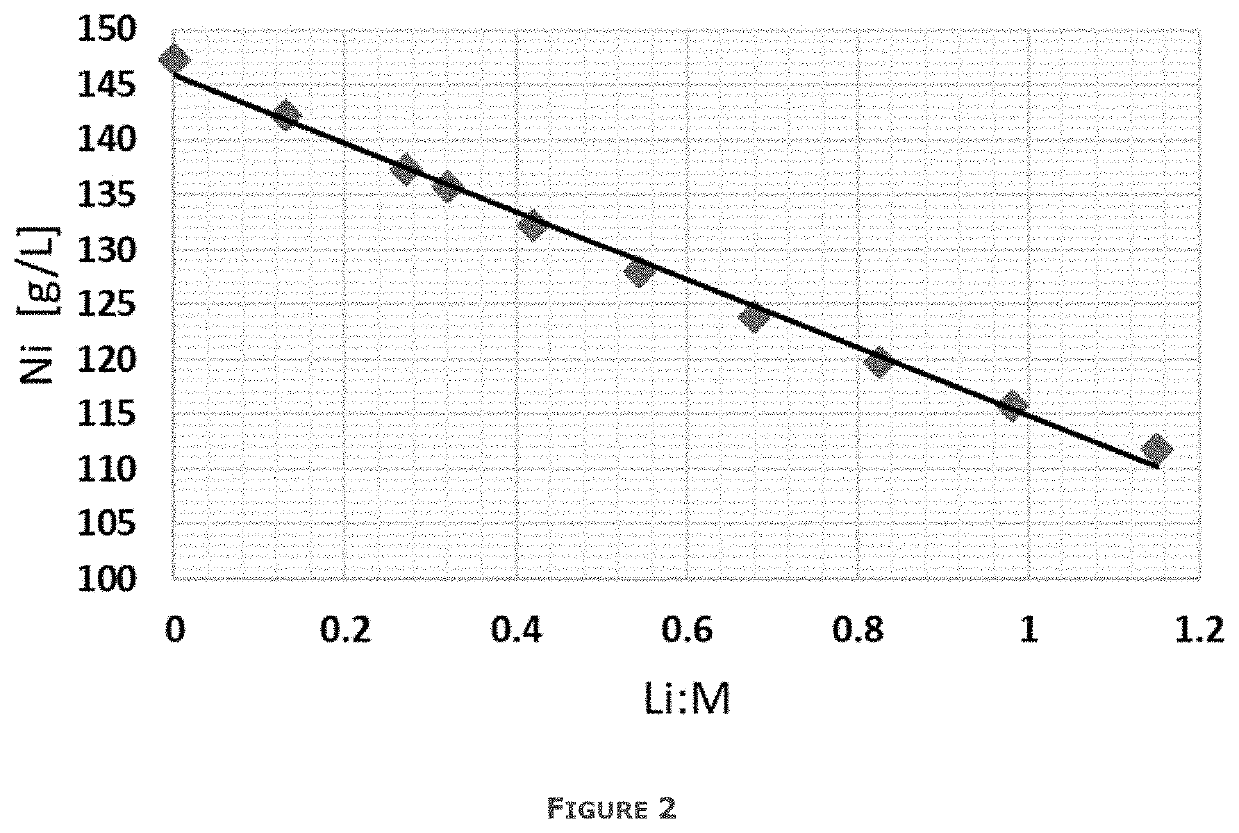Process for the preparation of battery precursors
a battery precursor and process technology, applied in the field of process for the preparation of battery precursors, can solve the problems of production waste generation, more complex waste streams, and the chemical complexity of scrapped materials increasing towards the end of the manufacturing process
- Summary
- Abstract
- Description
- Claims
- Application Information
AI Technical Summary
Benefits of technology
Problems solved by technology
Method used
Image
Examples
example 1
[0065]End of life batteries are recycled in a 60-liter alumina crucible. The end-of-life batteries contain 10 wt % Al, 2 wt % Fe, 4 wt % Mn, 4 wt % Co, 9 wt % Cu, 13 wt % Ni, 2.5 wt % Li, 25 wt % C. The rest comprises for example elements such as hydrogen, oxygen and fluorine.
[0066]A starting slag is heated to a temperature of 1450° C. using an induction furnace. Once this temperature is reached, a mixture of end-of-life batteries and fluxes are gradually added to the liquid slag over a period of 2 hours. Over this time, 50 kg of batteries are added together with 10 kg of limestone and 5 kg of sand. The Li:M ratio is 1.53 for a starting material including the end of life batteries, starting slag and fluxing agents as described. O2 is blown at a rate of 220 L / h above the bath during the loading of the feed to combust any metallic Al and carbon in the batteries. Once the final addition is made, CO is blown through the bath at a rate of 300 L / h for 1 hour to obtain the desired reductio...
example 2
[0074]Mechanically pretreated cathode foil production waste, called black mass, is first thermally pretreated in presence of a reducing agent C in order to remove Li prior to leaching. The black mass contains 33% Ni, 11% Co, 10% Mn, <0.1% Cu, <0.1% Fe, 0.4% Al, 6.1%Li. The rest comprises for example elements such as oxygen, carbon and fluorine. The Li:M ratio of the starting material is 0.94.
[0075]300 g of black mass, mechanically pretreated cathode foil production waste with a composition stated above, is mixed with 15.6 g Carbon and 244.8 g CaCl2.2H2O. This mixture is put in in a tray and heated to a temperature of 700° C. in an electric furnace while the furnace is constantly purged with N2 flow. The temperature of 700° C. is maintained for a period of 6 hours. Over this time, the Ni, Mn and Co oxides are (partly) reduced and a water-soluble Li salt, i.e. Li2CO3 and / or LiCl, are formed. After 6 hours, the furnace with mixture is cooled down to room temperature under N2 atmosphere...
example 3
[0080]200 g of nickel-cobalt-aluminium (NCA) cathode production scrap is treated. The production scrap contains 48% Ni, 9% Co, <0.1% Mn, 2% Al, 7% Li. The rest comprises for example elements such as oxygen. The Li:M ratio of the starting material is 1.04.
[0081]The 200 g of cathode production scrap is added in a 2L reactor with 1L water. This mixture is agitated and heated to a temperature of 80° C. on a heating plate. 220 mL of sulfuric acid with concentration of 987 g / L is added in 6 hours. In such conditions, Li dissolves, whereas trivalent Co and Ni do not dissolve. After six hours, the solid-liquid mixture is filtered on a Buchner filter.
[0082]Around 1.1 L of filtrate is recovered. By this operation, the majority of the Lithium is leached and present in the filtrate. 107 g of a Li-depleted residue is obtained that is rich in Ni and Co. The composition of the filtrate and residue after drying can be found in Table 3.1. The Li removal yield is more than 99% in the selective Li lea...
PUM
| Property | Measurement | Unit |
|---|---|---|
| temperature | aaaaa | aaaaa |
| pH | aaaaa | aaaaa |
| diameter | aaaaa | aaaaa |
Abstract
Description
Claims
Application Information
 Login to View More
Login to View More - R&D
- Intellectual Property
- Life Sciences
- Materials
- Tech Scout
- Unparalleled Data Quality
- Higher Quality Content
- 60% Fewer Hallucinations
Browse by: Latest US Patents, China's latest patents, Technical Efficacy Thesaurus, Application Domain, Technology Topic, Popular Technical Reports.
© 2025 PatSnap. All rights reserved.Legal|Privacy policy|Modern Slavery Act Transparency Statement|Sitemap|About US| Contact US: help@patsnap.com


